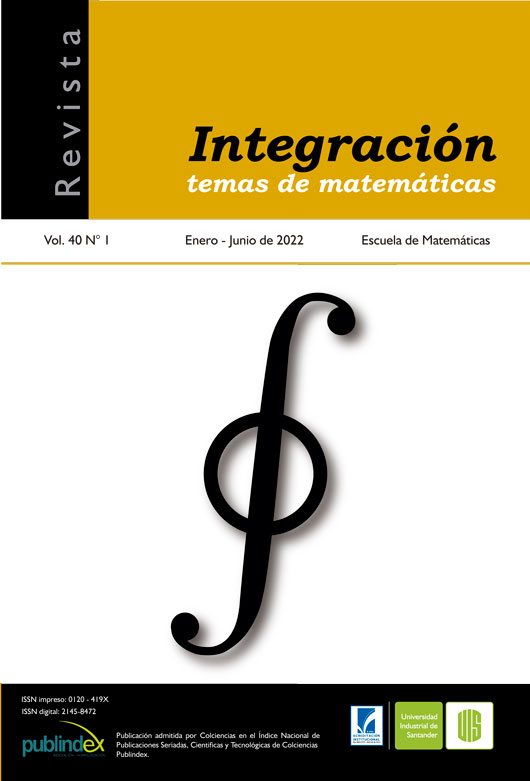Artículos científicos
Publicado 2022-03-01
Palabras clave
- Dinámica de población,
- migración asimétrica,
- ecuación logística,
- sistemas lentos y rápidos,
- mezcla perfecta
Cómo citar
Elbetch, B., Benzekri, T., Massart, D., & SARI, T. (2022). La ecuación logística de múltiples sitios con migración asimétrica. Revista Integración, Temas De matemáticas, 40(1), 25–57. https://doi.org/10.18273/revint.v40n1-2022002
Derechos de autor 2022 Revista Integración, temas de matemáticas

Esta obra está bajo una licencia internacional Creative Commons Atribución 4.0.
Descargas
Los datos de descargas todavía no están disponibles.
Referencias
- Arditi R., Lobry C. and Sari T., “Is dispersal always beneficial to carrying capacity? New insights from the multi-patch logistic equation”, Theor. Popul. Biol., 106 (2015), 45-59. doi: 10.1016/j.tpb.2015.10.001
- Arditi R., Lobry C. and Sari T., “Asymmetric dispersal in the multi-patch logistic equation”, Theor. Popul. Biol., 120 (2018), 11-15. doi: 10.1016/j.tpb.2017.12.006
- Arino J., Bajeux N. and Kirkland S., “Number of source patches required for population persistence in a source–sink metapopulation with explicit movement”, Bull. Math. Biol., 81 (2019), No. 6, 1916-1942. doi: 10.1007/s11538-019-00593-1
- Arino J., “Diseases in metapopulations”, in Modeling and Dynamics of Infectious Diseases (eds. Ma Z., Zhou Y. and Wu J.), World Scientific (2009), 64-122. doi: 10.1142/9789814261265%_%0003
- Cosner C., Beier J.C., Cantrell R.S., Impoinvil D., Kapitanski L., Potts M.D., Troyo A. and Ruan S., “The effects of human movement on the persistence of vector-borne diseases”, J. Theoret. Biol., 258 (2009), No. 4, 550-560. doi: 10.1016/j.jtbi.2009.02.016
- Castillo C. and Thieme H.R., “Asymptotically autonomous epidemic models”, in Mathematical Population Dynamics: Analysis of Heterogeneity 2 (eds. Arino O., Axelrod D.E., Kimmel M., Langlais M.), Theory of Epidemics (1995), 33-50.
- Castillo G., C.W. and Castillo C., “A Tour of the Basic Reproductive Number and the Next Generation of Researchers”, in An Introduction to Undergraduate Research in Computational and Mathematical Biology (eds. Callender H., Capaldi A., Diaz C.), Nature Publishing Group (2020), 87-124.
- DeAngelis D.L., Travis C.C. and Post W.M., “Persistence and stability of seed-dispersel species in a patchy environment”,Theoret. Popul. Biol., 16 (1979), No. 2, 107-125. doi: 10.1016/0040-5809(79)90008-X
- DeAngelis D.L., Ni W. and Zhang B., “Dispersal and heterogeneity: single species”, J. Math. Biol., 72 (2016), No. 1-2, 239-254. doi: 10.1007/s00285-015-0879-y
- DeAngelis D.L., Ni W. and Zhang B., “Effects of diffusion on total biomass in heterogeneous continuous and discrete-patch systems”, Theor. Ecol., 9 (2016), No. 4, 443-453. doi: 10.1007/s12080-016-0302-3
- DeAngelis D.L. and Zhang B., “Effects of dispersal in a non-uniform environment on population dynamics and competition: a patch model approach”, Discrete Contin. Dyn. Syst. Ser. B, 19 (2014), No. 10, 3087-3104. doi: 10.3934/dcdsb.2014.19.3087
- Elbetch B., Benzekri T., Massart D. and Sari T., “The multi-patch logistic equation”, Discrete Contin. Dyn. Syst. Ser. B, 26 (2021), No. 12, 6405-6424. doi: 10.3934/dcdsb.2021025
- Freedman H.I., Rai B. and Waltman P., “Mathematical Models of Population Interactions with Dispersal II: Differential Survival in a Change of Habitat”, J. Math. Anal. Appl., 115 (1986), No. 1, 140-154. doi: 10.1016/0022-247X(86)90029-6
- Freedman H.I. and Waltman P., “Mathematical Models of Population Interactions with Dispersal I: Stability of two habitats with and without a predator”, SIAM J. Appl. Math., 32 (1977), No. 3, 631-648. doi: 10.1137/0132052
- Gao D., “How does dispersal affect the infection size?”, SIAM J. Appl. Math., 80 (2020), No. 5, 2144-2169. doi: 10.1137/19M130652X
- Gao D. and Dong C.P., “Fast diffusion inhibits disease outbreaks”, Proc. Am. Math. Soc., 148 (2020), No. 4, 1709-1722. doi: 10.1090/proc/14868
- Guo H., Li M. and Shuai Z., “Global stability of the endemic equilibrium of multigroup SIR epidemic models”, Can. Appl. Math. Q., 14 (2006), No. 3, 259-284.
- Holt R.D., “Population dynamics in two patch environments: some anomalous consequences of an optimal habitat distribution”, Theor. Popul. Biol., 28 (1985), No. 2, 181-208. doi: 10.1016/0040-5809(85)90027-9
- Hanski I., Metapopulation Ecology, Oxford University Press, 1st ed., New York, 1999.
- Levin S.A., “Dispersion and population interactions”, Amer. Natur., 108 (1974), No. 960, 207-228. doi: 10.1086/282900
- Levin S.A., “Spatial patterning and the structure of ecological communities”, in Some Mathematical Questions in Biology (ed. Oster G.), Lecture Notes on Mathematics in the Life Sciences (1976), 1-35.
- Lobry C., Sari T. and Touhami S., “On Tykhonov’s theorem for convergence of solutions of slow and fast systems”, Electron. J. Differential Equations, 19 (1998), 1-22.
- Markus L., “Asymptotically autonomous differential systems”, in Contributions to the Theory of Nonlinear Oscillations III, (ed. Lefschetz S.), Princeton University Press (1956), 17-30. doi: 10.1515/9781400882175-003
- Nagahara K., Lou Y. and Yanagida E., “Maximizing the total population with logistic growth in a patchy environment”, J. Math. Biol., 82 (2021), No. 1, 1-50. doi: 10.1007/s00285-021-01565-7
- Poggiale J.C., Auger P., Nérini D., Manté C. and Gilbert F., “ Global production increased spatial heterogeneity in a population dynamics model”, Acta Biotheoretica, 53 (2005), No. 4, 359-370. doi: 10.1007/s10441-005-4890-3
- Thieme H.R., “Convergence results and a Poincaré-Bendixson trichotomy for asymptotically autonomous differential equations”, J. Math. Biol., 30 (1992), No. 7, 755-763. doi: 10.1007/BF00173267
- Thieme H.R., “Asymptotically Autonomous Differential Equations in the Plane”, Rocky Mountain J. Math., 24 (1993), No. 1, 351-380. doi: 10.1216/rmjm/1181072470
- Tikhonov A.N., “Systems of differential equations containing small parameters in the derivatives”, Mat. Sb. (N.S.), 31 (1952), No. 3, 575 586.
- Van den Driessche P. and Watmough J., “Further Notes on the Basic Reproduction Number”, in Mathematical Epidemiology (eds. Brauer F., van den Driessche P., Wu J.), Lecture Notes in Mathematics (2008), 159-178. doi:10.1007/978-3-540-78911-6_6
- Wu H., Wang Y., Li Y. and DeAngelis D.L., “Dispersal asymmetry in a two-patch system with source-sink populations”, Theor. Popul. Biol., 131 (2020), 54-65. doi: 10.1016/j.tpb.2019.11.004
- Wasow W.R., Asymptotic Expansions for Ordinary Differential Equations, Robert E. Krieger Publishing Company, Huntington, New York, 1976.
- Yurk B.P. and Cobbold C.A., “Homogenization techniques for population dynamics in strongly heterogeneous landscapes”, J. Biol. Dyn., 12 (2018), No. 1, 171-193. doi: 10.1080/17513758.2017.1410238
- Zaker N., Ketchemen L. and Lutscher F., “The Effect of Movement Behavior on Population Density in Patchy Landscapes”, Bull. Math. Biol., 82 (2020), No. 1, 1-24. doi: 10.1007/s11538-019-00680-3

